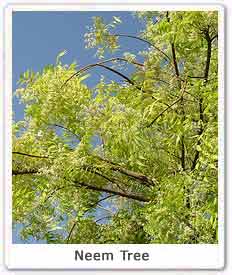| Kingdom : | Plantae |
| Division | Magnoliophyta |
| Class: | Magnoliopsida |
| Order : | Sapindales |
| Family : | Meliaceae |
| Genus : | Azadirachta |
| Species : | A. indica |
| Scientific Name : | Azadirachta indica |
| Found In : | Ranthambore National Park, Bandhavgarh national Park, Mrugavani Naional Park, Bannerghata National Park, Sariska Wildlife sanctuary and Guindy National Park. |
Other names : It is popularly known as the miracle tree. It is known as Nimba in India. The Sanskrit name of Neem is Arishtha meaning the reliever of the sickness. Margosa tree
Description : It is a tall evergreen tree with the small bright green leaves. It is up to 100 feet tall. It blossoms in spring with the small white flowers. It has a straight trunk. Its bark is hard rough and scaly, fissured even in small trees. The colour of the bark is brown grayish. The leaves are alternate and consists of several leaflets with serrated edges. Its flowers are small and white in colour. The loive like edible fruit is oval, round and thin skinned.
 Other
Species : A. juss, A. azedarac are the other related species of Neem
tree. A. juss, A. azedarac are the other related species of Neem tree. A.
juss, A. azedarac are the other related species of Neem tree.
Other
Species : A. juss, A. azedarac are the other related species of Neem
tree. A. juss, A. azedarac are the other related species of Neem tree. A.
juss, A. azedarac are the other related species of Neem tree. Location : Neem tree is found throughout India. It is a popular village tree. Although it is also widely grown in Ranthambore National Park, Bandhavgarh national Park, Mrugavani Naional Park, Bannerghata National Park, Sariska Wildlife Sanctuary and Guindy National Park.
Cultivation : Neem tree can easily be grown in the dry, stony, shallow and clayey soils. It needs very little water and plenty of sunlight. It grows slowly during the first year of planting. It can be propagated through the seeds and cuttings. Young neem tree can not tolerate excessive cold. .
Medicinal uses : The indigenous people of Nilgiris consume the dried and powered tubulers of the terrestrial orchids as an energizing tonic. Neem also holds medicinal value. Each part of neem is used in the medicines. It has been used in Ayurvedic medicines for more than 4000 years. Neem oil extracted from its seeds is used in medicines, pest control and cosmetics etc. Its leaves are used in the treat Chickenpox.. According to the Hindus, it is believed that the Goddess of the chickenpox, Sithala lives in the Neem tree. Neem tea is usually taken to reduce the headache and fever. Its flowers are used to cure intestinal problems. Neem bark acts as an analgesic and can cure high fever as of malaria. Even the skin diseases can be cured from the Neem leaves. Indians even believe that the Neem can even purify diseases.
Other uses : People in India use its twigs to brush their teeth. Neem is considered as the useful tree in rehabilitating the waste land areas. Neem seed pulp is useful for methane gas production. It is also useful as carbohydrate which is rich base for other industrial fermentations. Neem bark contains tannins which are used in tanning and dyeing. In south India its wood is used to make the furniture. The bark of the yields the fiber that is woven into ropes. Neem cake is widely used in India as fertilizer for sugarcane, vegetable and other cash crops. Many countries have been consistently growing the Neem tree against the global warming. The worldwide Neem Foundation has helped in making the people aware about the importance of neem and its uses globally.
Cultural Importance : One can find Neem in almost all the parts of India. It is said that planting Neem tree in the house is a ensured passage to heaven. Its leaves are stung on the main entrance to remain away from the evil spirits. Brides take bath in the water filled with the Neem leaves. Newly born babies are laid upon the Neem leaves to provide them with the protective aura. Neem gives out more oxygen than other trees. The neem tree is also connected with the Sun, in the story of Neembark 'The Sun in the Neem tree'. Neem is the wonder tree and finds mention in the number of ancient texts.






